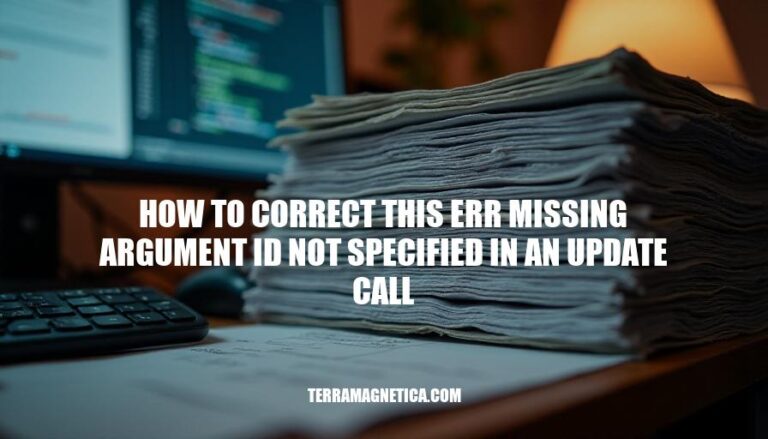The error “missing argument id not specified in an update call” typically occurs in data operations when an update request lacks the necessary record ID. This ID is crucial for identifying which record to update. Without it, the system cannot proceed, leading to failed updates. This error is common in platforms like Salesforce, especially during bulk data operations or when using tools like Data Loader. Its impact includes halted processes and potential data inconsistencies, making it essential to ensure IDs are correctly specified in update calls.
Understanding the Error
The error “missing argument id not specified in an update call” occurs under the following conditions:
- Blank ID Field: The ID field is empty or null in the update request.
- Improper Mapping: The ID column in the data source (e.g., CSV file) is not correctly mapped to the ID field in the target system.
- Invalid ID Format: The ID provided does not match the expected format or is not a valid ID in the system.
- Missing ID in Batch Update: When performing batch updates, if any record in the batch lacks an ID, the entire batch may fail.
- Incorrect Field Reference: The ID field is incorrectly referenced or misspelled in the update call.
These conditions must be checked and corrected to resolve the error.
Identifying the Cause
-
Check Data Mappings:
- Ensure the ID column in your CSV file is mapped to the ID field in your system.
- Verify that the correct fields are mapped, especially if using a tool like Data Loader.
-
Validate IDs:
- Confirm that the ID column contains valid, non-blank IDs.
- Ensure the IDs are of the correct type and format.
-
Review Update/Upsert Settings:
- For upserts, make sure the ID column is mapped even if all records are new.
Steps to Correct the Error
-
Verify ID Fields:
- Ensure the ID field is present in your data source (e.g., CSV file).
- Confirm the ID values are correct and not empty.
-
Correct Mappings:
- Map the ID field in your data source to the corresponding ID field in your update tool (e.g., Salesforce Data Loader).
-
Re-run the Update:
- Execute the update operation again with the corrected mappings.
-
Check for Errors:
- Review any error messages to ensure the update was successful.
- If errors persist, re-verify the ID fields and mappings.
-
Repeat if Necessary:
- Repeat the process until the update completes without errors.
Preventing Future Occurrences
-
Thorough Data Validation:
- Ensure all required fields, especially IDs, are populated before making update calls.
- Implement client-side validation to catch missing or incorrect data early.
-
Proper Field Mapping:
- Always map the ID column correctly when performing updates or upserts.
- Use tools like Swagger to maintain accurate API specifications.
-
Clear API Documentation:
- Maintain up-to-date and clear API documentation to guide proper usage.
-
Error Monitoring:
- Monitor and log errors to identify and address recurring issues.
-
Custom Fields:
- Create and map custom fields if using internal IDs from different systems.
These practices will help prevent the ‘missing argument id not specified in an update call’ error in your data operations.
To Correct the ‘Missing Argument id Not Specified in an Update Call’ Error
Ensure accurate data handling by checking and correcting the following:
- Blank ID fields
- Improper mapping
- Invalid ID format
- Missing IDs in batch updates
- Incorrect field references
Validate IDs, review update/upsert settings, verify ID fields, correct mappings, re-run the update, check for errors, and repeat if necessary.
Implement thorough data validation, proper field mapping, clear API documentation, error monitoring, and custom fields to prevent recurring issues.


